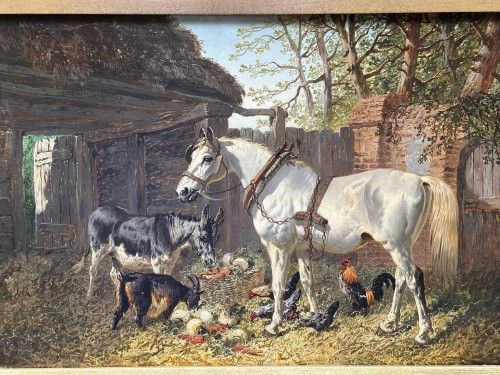A French Chasseur a Cheval de la Garde Imperiale, drinking outside a Inn or Pub
REF: 2398
A French Chasseur a Cheval de la Garde Imperiale, drinking outside an Inn or Pub.
Frank Moss Bennett was born in Liverpool, England on 15 November 1874 to Henry Mellor Bennett and Kate née Stuart. He was the second of four sons and his father, an Iron Founder and later the Mayor of Liverpool, was a philanthropist. Not much is known about Bennett’s early education except that he was probably taught at home with his brothers, and that he showed a talent for painting at an early age. As noted by Maureen Elizabeth Son in her book Frank Moss Bennett, 1874-1952 (The Forgotten Artist), Bennett’s earliest known artwork was a Christmas card that he painted for his grandfather when he was five years old. Bennett enrolled at Browns House, Clifton College in Bristol where he studied until 1892. He then decided that he wanted to become an artist and enrolled that year, in the Slade School of Art in London, where he met Eddie Wells who would become a close friend and later his brother-in-law. Together they studied under some well-known artists such as Henry Tonks, Philip Wilson Steer, and John Singer Sargent. In 1894, Bennett went to St. Johns Wood School of Art where he spent a few months, before joining the Royal Academy School of Art in 1986. While studying at the Academy, he won a gold medal and a travel scholarship in 1899 for his lithograph entitled ‘Ladas the Greek runner falling dead as he goes to receive his crown of wild olives at Olympia’. While Bennett established his reputation in portraiture, it was in the realm of genre paintings that he truly became popular. Like some other artists working during the late nineteenth century, he favoured the historic genre, which continued to appeal to art patrons. He was particularly influenced by the French artist Jean-Louis-Ernest Meissonier, who was famous for the meticulous and accurate historical rendition of his subjects, and his eighteenth century scenes of readers, philosophers, and card players. Bennett aspired to achieve historical accuracy in his paintings. He would use the furniture that he himself had designed, restored and made in his pictures, and would dress his models in historical costumes, of which he had a very large collection. Bennett enjoyed public success during his lifetime. He exhibited his works in London at the Royal Academy from 1898 until 1928, Liverpool Art Gallery from 1899 until 1832; the Royal Institute of Watercolor Painters; Royal Institute of Oil Painters; Rembrandt Gallery, and at the Paris Salon in France. Furthermore, Bennett sold many of his works through a number of art dealers mostly in London
- Height 30.48 cm / 12 "
- Width 35.56 cm / 14 "
RELATED ITEMS




























